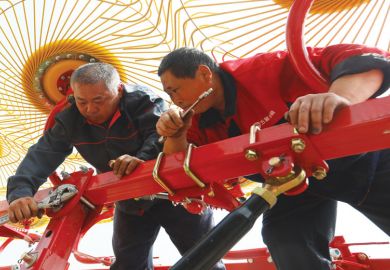The private car is perceived as the way individuals can guarantee their freedom of movement. The acquisition of a car has become a worldwide aspiration. Governments like it: the provision of a flat surface of tarmac allows people to go about their business without complaining to the state. Thus central government policy and local planning decisions over the past 50 years have continually encouraged the trend towards increasing car use.
But provision for increased car use, particularly in urban areas, has gradually eroded accessibility, even for car users. There is a constant demand to create more road space. The provision of ring roads and city-centre feeder roads and the increasing dispersion of destinations that results from this policy has made alternative transport systems less of an option.
World Transport Policy and Practice was established in 1995. Its fundamental ethos is that to escape this cycle, there must be a change in the way national, regional and local planning authorities plan for the movements of goods and people. The objective of the journal was to find ways to achieve "a reduction in the use of the car and the diesel lorry", which the editors identified as an "extremely inefficient and divisive mode of transport".
The journal publishes articles on a wide range of topics relating to the problems of mobility and transport planning, particularly in cities. There have been special issues on teleworking, car-share and sustainable freight movement. Geographical issues are also possible, with volumes so far on Calcutta and Israel.
In early issues, there was considerable emphasis on case studies and the problems of existing transport policies, with an encouragement of walking and cycling and emphasis on the difficulty of reversing the trend and reducing car use. Since 1997, discussion of environmentally sustainable transport systems has led to a re-evaluation of the role of the car. More and more papers now look at ways to tame and control the car. Finally discussion has turned towards the provision of mobility systems in which the car might just be able to play an important role.
The feeling in the journal's early years that the car was itself the enemy has gradually been modified. There is now wide acceptance that the main problems of pollution, accidents and the space and capacity implications of unlimited private car use can be at least partly addressed.
In the developing world, many cities have very efficient transit routes formed simply from thousands of privately owned taxis running on generally agreed routes with flat fares. When you need to go off-route, you charter one and pay a distance-related fare. Shared taxis are a possible solution to many low-capacity public transport routes, but in Britain they do not exist.
Support is growing for the view that the journal should work towards a curtailment of the total freedom of the car. The dilemma for politicians is that some 85 per cent of journeys today are provided by the car, many fulfilling a purpose that the individual does not believe can be provided in any alternative way. Any attack on the car is an attack on individual freedom. The journal often talks of targets for reduction in car usage and the idea of car-free days. While these measures motivate activists, surely they inconvenience most of the population who do not see their car in the same light and who will largely simply stay at home.
The British government recently appeared to backtrack on car-limitation policies for Britain for this very reason, following the strong reactions provoked by increases in the price of petrol. This story is well documented in the journal. But it is the planning rules that need to change, and turning around planning policy enshrined in 50 years of legislation can never be easy. Increased car use is the effect, not the cause, of long-term planning policies. Use will drop when alternatives exist and the need to drive around aimlessly is removed.
For instance, most pedestrianisations in towns are reported as having the exact opposite effect to building a road: the traffic simply disappears. Research documenting the increase of traffic that accompanies road building was published in early editions of the journal. Provision of a new rail tram route immediately leads to increased use, even though people have to pay. A perception that new trains or trams are more interesting than a new car is something the government has now realised can generate political backing for a change in transport policy.
Additionally, most cities are now busy building houses in city centres and making positive moves towards traffic calming and reduction to bring back life into city centres. However, an incremental approach is likely to be the most practical way to success.
Difficult issues are raised by the discussion of sustainability, and it can be argued that it should not be a major criterion in planning transport systems. Surely quality of life and general access to transport to visit the locations necessary to support that quality of life safely should be the main priority? Achieving changes in transport priorities and guidelines within the planning system will inevitably lead to more environmentally sustainable transport systems. If sustainability is made a goal, it is easy for anyone to cloud the main issue.
In the journal's first issue in 1995, Stefanie Böge told the story of a yogurt sold as an environmentally sound product in a supermarket. She concluded that the yogurt was far from environmentally sound because of the accumulated distance it had been carried using fossil fuels. Recent events in the UK have highlighted the vast distances travelled by farm animals before coming to market.
This argument can be taken further. If most foods are not environmentally sustainable products, then cycling and walking, which use these foods as energy sources, are not at the moment sustainable forms of transport. Of course one can argue that we could change the fuel, but the same can be said for the car. And certainly the electric tram or high-speed train, which can be fuelled eventually by wind, river or wave-power generators for ever, must be considered more sustainable than walking or cycling.
Incremental change has to be considered. A town initially grows with its markets in the centre. As the city expands, people buy vehicles and transit times increase because of congestion. Suburban centres develop with their own services, which people can reach more easily. As traffic builds up, a ring road is planned to distribute traffic, and suburbs are built on open plan to allow car movement. Private development starts to take place along the ring road.
The catchment is increased, but the economy of the town suffers and each centre, increasingly dependent on private transport, becomes able to support fewer commercial outlets. The town centre suffers as it becomes too remote and too difficult to reach.
In a developing city, this scenario can be avoided by supplying public transport between centre ring-road developments and suburbs that can carry the required traffic flows and allow close-spaced development. This transport system could be funded retrospectively by commercial gain from the release of vast areas of tarmac for commercial use (car-access charges are appropriate only in cities that have well-developed transit systems). The private-public funding arrangements that the British government appears to be pursuing are a first step down this route.
A consensus appears to be emerging that a combination of measures is required to reduce dependency on private car use: integrated public transport systems; incremental reallocation of land in cities and towns to pedestrian, cycle and public transport use as appropriate; and people-centred planning of new development.
Most articles in the journal can be read and understood by the informed lay reader; and they are available free of charge in electronic format. Accessing the journal is a must for anyone who has spent the day in a theme park with the family and wondered at the end of the day why they feel so relaxed, or who has sat in a traffic jam and wondered why their government does not do something about it.
Leslie Wright is vice-president (exploration), Mano River Resources, and visiting research fellow, University of Southampton.
World Transport Policy and Practice
Editor - John Whitelegg with Eric Britton, John Howe, Mikel Murga and Paul Tranter
ISBN - ISSN 1352 7614
Publisher - EcoPlan and Eco-Logica
www.ecoplan.org/wtpp
Price - Free to download $60/€60 (individuals) $120/E120 (institutions)



